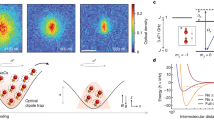Abstract
RECENT investigations1–3 on the radiation-induced polymerization of certain monomers have provided evidence for the production of ionic as opposed to radical initiation. The polymerization of such monomers can be initiated by Friedel–Crafts catalysts, and cyclopentadiene4 falls into such a class. Pure, rigorously dried (silica-gel treated) cyclopentadiene was irradiated with cobalt-60 γ radiation (dose-rate 2.27 × 1017 eV g−1 min−1). At − 78.5° C a gel was formed after conversion of 1.6 per cent of the monomer to polymer. The results of carbon, hydrogen analysis fitted an empirical formula of C5H6. The gelling dose was 8.5 × 1017 eV g−1, and the subsequent increased rate of polymer formation corresponded to the removal of 17,760±1,521 (S.D.) monomer molecules per 100 eV. This was linear with dose up to at least 40 per cent conversion. At 0° C the yields were lower and suffered a high degree of irreproducibility (G(-monomer) range of 1,518–12,750). At 22° C a dimer impurity could not be excluded owing to its spontaneous thermal formation4, but polymerization did ensue in one experiment with an overall (G(-monomer) yield of 10,600 at 15 per cent conversion. In the absence of silicagel drying the yields were substantially reduced. The efficiency of the reaction at low temperature, and the necessity for rigorous drying2 to attain high yield are criteria for the non-participation of radical processes.
This is a preview of subscription content, access via your institution
Access options
Subscribe to this journal
Receive 51 print issues and online access
$199.00 per year
only $3.90 per issue
Buy this article
- Purchase on Springer Link
- Instant access to full article PDF
Prices may be subject to local taxes which are calculated during checkout
Similar content being viewed by others
References
For review see Magat, M., J. Polymer Sci., 48, 379 (1960).
Bates, T. H., and Williams, T. F., Nature, 187, 665 (1960). Bates, T. H., Best, J. V. F., and Williams, T. F., ibid., 188, 469 (1960).
Best, J. V. F., Bates, T. H., and Williams, T. F., Trans. Faraday Soc., 58, 192 (1962).
Wilson, P. J., and Wells, J. H., Chem. Rev., 34, 1 (1944).
Staudinger, H., and Bruson, H. A., Ann., 447, 97 (1926).
Collinson, E., Dainton, F. S., and Gillis, H. A., J. Phys. Chem., 63, 909 (1959).
Charlesby, A., Pinner, S. H., and Worrall, R., Proc. Roy. Soc., A, 259, 386 (1960).
Charlesby, A., Atomic Radiation and Polymers, 177 (Pergamon Press, 1960).
Pepper, D. C., Quart. Rev., 8, 105 (1954).
Author information
Authors and Affiliations
Rights and permissions
About this article
Cite this article
BATES, T. Radiation-induced Ionic Reactions: Cyclopentadiene Polymerization. Nature 197, 1101–1102 (1963). https://doi.org/10.1038/1971101b0
Issue Date:
DOI: https://doi.org/10.1038/1971101b0
Comments
By submitting a comment you agree to abide by our Terms and Community Guidelines. If you find something abusive or that does not comply with our terms or guidelines please flag it as inappropriate.



